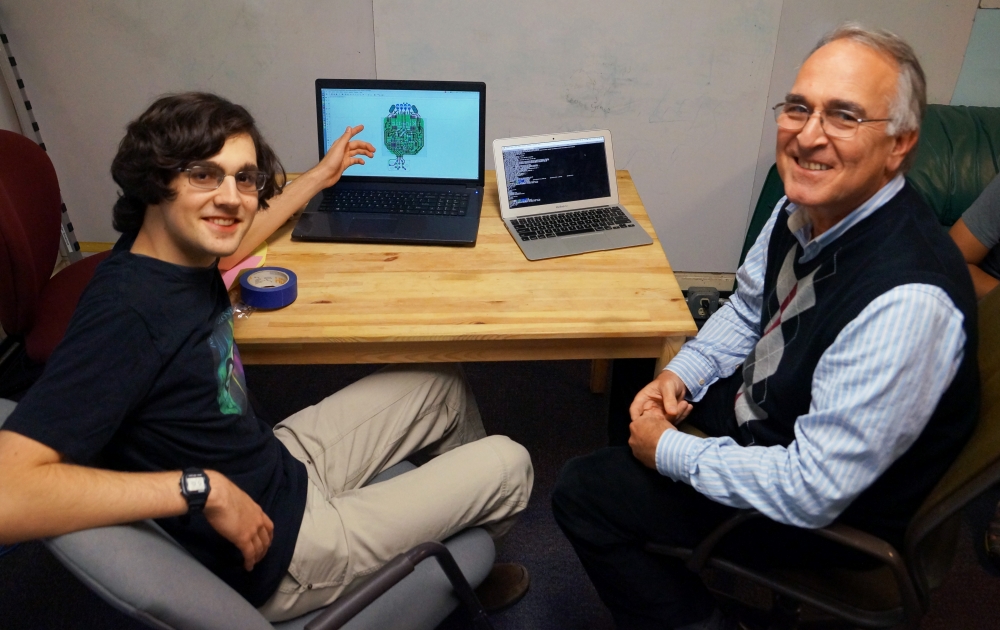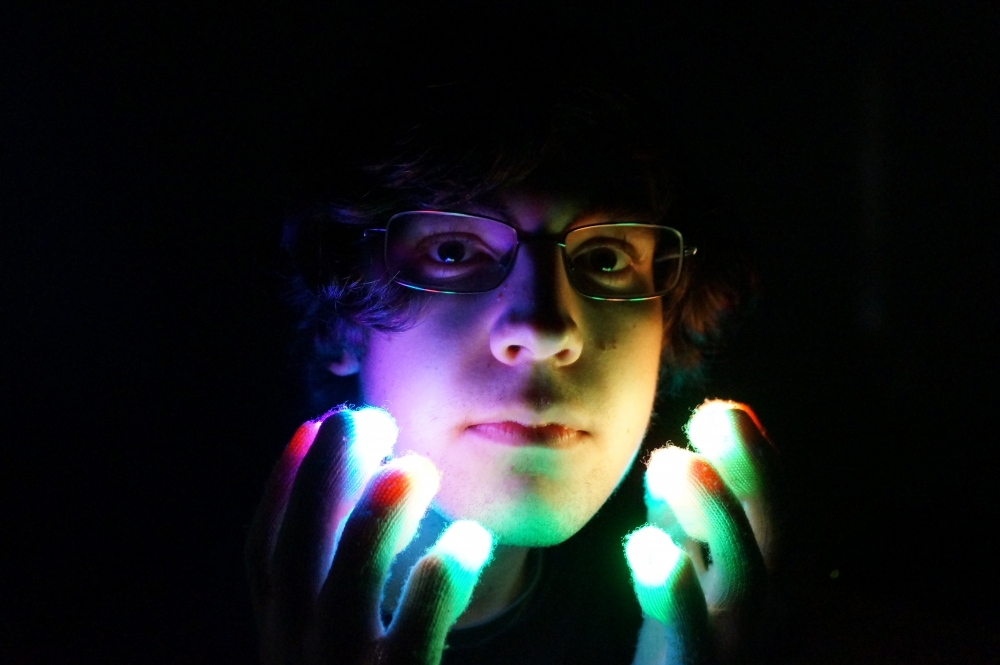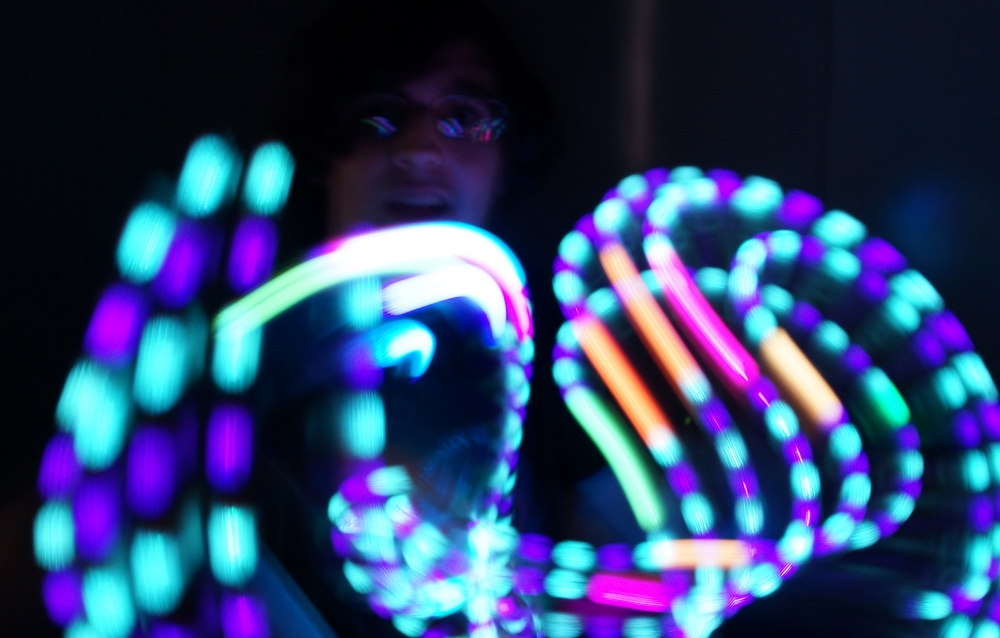Tripping the Light Fantastic

When UC Santa Barbara freshman Abraham Karplus put his project on Kickstarter last month, he knew there was a good chance he’d make his $20,000 goal in the 30-day life of his campaign. What he didn’t expect, however, was to reach his goal within half an hour and triple it by the end of the crowdfunding endeavor.
“I’m excited by just how large and positive the reaction to the Kinetic has been,” said Karplus, a student in UCSB’s College of Creative Studies. With business partner and friend Zohar Wouk, Karplus developed the Kinetic, a motion-reactive LED glove that changes colors with movement. The gloves represent the next, and more sophisticated generation of technology made for the rave culture art form known as “gloving.”
So what is gloving? Imagine yourself at a rave, in the dark, with a surging crowd feeding off the booming energy of electronic dance music and laser light shows.
For many ravers, however, watching the light show is not enough; they want to be the light show, hypnotizing themselves and the other partygoers with glowing, spinning blinking lights.
This is where gloving comes in. With special LED-tipped gloves, glovers weave psychedelic patterns into the darkness, leaving light trails around themselves that appear and change according to the music, the glover’s movements, and their technique. This temporal light show has become so popular that various styles of gloving have evolved, and competitions exist for ravers to out-glove each other.
Karplus was still a homeschooled high school junior in Santa Cruz when he and Wouk, a classmate, got together as the company Futuristic Lights to design and prototype what would become the world’s first motion-reactive LED gloves, by adding an accelerometer — the same kind of device found in fitness monitoring devices and smartphones to sense motion and direction — that would adapt the lights’ colors and patterns to the glover’s movements.
“The novelty of a light that changes colors as it is moved is exciting for everyone, and glovers specifically can see the potential for expression it will allow them in their shows,” he said.
The biggest challenge in the design process for the Kinetic was fitting everything onto a circuit board small enough to be unobtrusive, according to Karplus. Indeed, each circuit board had to be roughly 1.4 cm by 1.8 cm to comfortably fit on each fingertip while still being able to contain a high-performance, low-current processor that needed to run calculations from the accelerometer data and still have flash memory for the firmware he created. Other challenges had to do with keeping the cost of circuit board manufacture low enough to be able to offer the gloves at a reasonable price.
Karplus took his project with him to UCSB, where he was admitted to CCS’s computer science program. There he was able to continue the development of the Kinetic, and take advantage of access to advisers in the cross-disciplinary setting needed to continue his project.
According to UCSB College of Engineering computer science professor Omer Egecioglu, the program chair for CCS computer science program, “the computer science program in the College of Creative Studies, like its seven sister programs in the college, admits only the best and the brightest high school students. Our purpose is to give the young minds the excitement of creative work, innovation and research — an opportunity to work in research projects as team members alongside our graduate students. That’s why the college’s motto is ‘A graduate school for undergraduates.’”
In the CCS computer science program, the students demonstrate their innovations at the end of their second year in a mid-residency review.
“As amazing as these innovations are, it is unusual to have a project of the caliber of one of these produced by a freshman,” said Egecioglu. “That’s what Abe brought to UCSB at the beginning of his studies here. His project combines hardware, software and business — many different and important aspects of computer science and entrepreneurship.”
Karplus’s project has resulted not only in the creation of a product that glovers everywhere are clearly excited about, but also in a deep learning experience for its creators.
“Before co-founding Futuristic Lights, my experience was mostly software, with the exception of some ill-fated robotics,” said Karplus. “In the past year and a half, however, I’ve learned so much more engineering, primarily circuit board design but also firmware programming and even some mechanical engineering.” Futuristic Lights, he said, is considering other projects.
For the would-be tech entrepreneurs out there, Karplus offers this bit of advice: Pace yourselves.
“It takes a long time,” said Karplus, pointing out the months, even years, of ironing out details of manufacture, engineering, business, legalities and customer support it takes to launch a new, innovative project. “Don’t be too ambitious with your first product,” he added. “Do one thing that no-one else does, or that no-one else does well, and leave your other great ideas for future iterations.”





